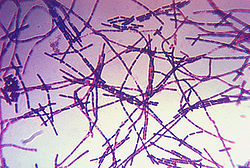Bacillus
Basic characteristics[edit | edit source]
In the genus' 'Bacillus ' includes gram-positive, aerobic or facultative anaerobic rods with dimensions from 0.5 to 1.2 µm (average) and the length often exceeds 10 µm. Bacterial motility is conditioned by peritrichally located flagella. A typical feature of a bacterium of the genus Bacillus is the formation of a single endospor, the size of which does not exceed the width of the bacterial cell. Endospore formation - sporulation, takes place only in the presence of oxygen. By oxidizing storage lipids, in particular poly-β-hydroxybutyric acid, the cell obtains the energy needed to form spores.
Sorting[edit | edit source]
The genus Bacillus can be divided into 3 groups according to the morphology of spores and sporangia:
- A group of low-nutrient bacteria whose elliptical spores do not cause sporangia to swell. According to cell width, this group of cells is divided into bacteria with cells larger than 1.0 μm ( B. megaterium , B. cereus , B. thuringiensis and B. anthracis ') and smaller cell bacteria (' 'B. subtilis, B. pumilis' ',' 'B. licheniformis, B. coagulans' ').
- A group of bacteria that form elliptical spores that cause sporangia to swell. ( B. circulans' ',' 'B. macerans, B. polymyxa , B. alvei , B. brevis' ',' 'B. stearothermophillus, ' 'B. popilliae' ',' 'B. larvae' ',' 'B. lentimorbus)
- A group of bacteria forms spherical spores. ( B. sphaericus )
Cultivation[edit | edit source]
The genus Bacillus in terms of cultivation, it is one of the undemanding bacteria that grows very easily on common soils.
Biochemical properties[edit | edit source]
Members of this genus are producing catalase. Most species produce proteolytic and amylolytic enzymes, but only some synthesize lecithinase ( B. cereus , B. thuringiensis , B. anthracis ) and a variety of hemolysins ( B. cereus , B. thuringiensis , B. megaterium ). We also currently use bacteria in the pharmaceutical industry to produce antibiotics of a polypeptide nature (bacitracin, gramicidin and polymyxin).
Pathogenicity[edit | edit source]
Bacillus anthracis is considered obligatory pathogenic. 'It is the originator of anthrax. Enterotoxicosis is a manifestation of toxins produced by B . cereus' , or some strains, such as' 'B. subtilis , B. pumilis , B. licheniformis . Other species are considered to be low pathogenic and apply only to immunocompromised people.
Pathogens and diseases[edit | edit source]
- 'B. cereus' - eye infections, wound infections, sepsis, endocarditis, osteomyelitis, meningitis and pneumonia
- 'B. alvei ',' B. circulans 'a' B. pumilis' - meningitis
- 'B. licheniformis ',' B. brevis ',' B. coagulans ',' B. macerans ',' B. sphaericus 'a' B. subtilis' - septic condition (sepsis)
- 'B. subtilis' - ulcerations, postoperative cellulitis, pneumonia
Links[edit | edit source]
Related articles[edit | edit source]
- Bacillus anthracis
- Sepsis
- Enterotoxicosis
- Endocarditis
- Osteomyelitis
- Meningitis
- Pneumonia
- Ulceration
- Celulitis
Source[edit | edit source]
- VOTAVA, Miroslav, et al. Lékařská mikrobiologie speciální. 1. vydání. Brno : Neptun, 2003. 495 s. ISBN 80-902896-6-5



